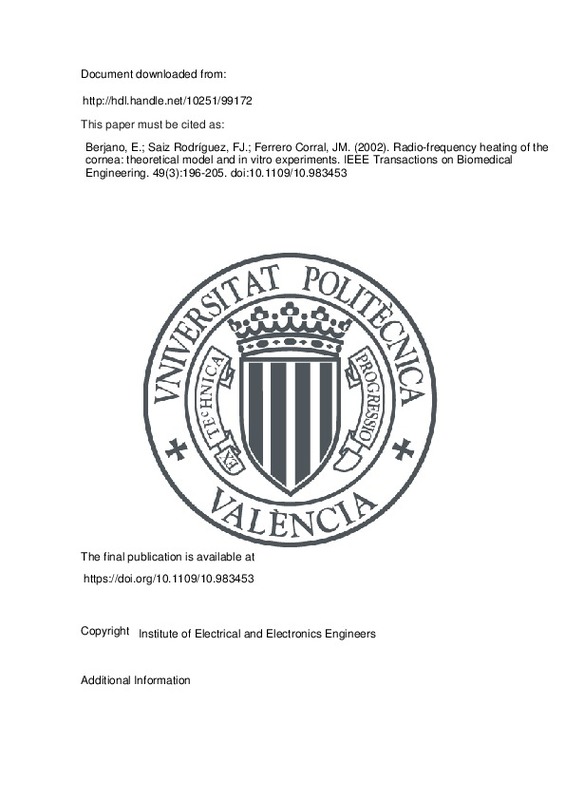JavaScript is disabled for your browser. Some features of this site may not work without it.
Buscar en RiuNet
Listar
Mi cuenta
Estadísticas
Ayuda RiuNet
Admin. UPV
Radio-frequency heating of the cornea: theoretical model and in vitro experiments
Mostrar el registro sencillo del ítem
Ficheros en el ítem
| dc.contributor.author | Berjano, Enrique
|
es_ES |
| dc.contributor.author | Saiz Rodríguez, Francisco Javier
|
es_ES |
| dc.contributor.author | Ferrero Corral, José María
|
es_ES |
| dc.date.accessioned | 2018-03-12T05:18:10Z | |
| dc.date.available | 2018-03-12T05:18:10Z | |
| dc.date.issued | 2002 | es_ES |
| dc.identifier.issn | 0018-9294 | es_ES |
| dc.identifier.uri | http://hdl.handle.net/10251/99172 | |
| dc.description.abstract | [EN] We present a theoretical model for the study of cornea heating with radio-frequency currents. This technique is used to reshape the cornea to correct refractive disorders. Our numerical model has allowed the study of the temperature distributions in the cornea and to estimate the dimensions of the lesion. The model incorporates a fragment of cornea, aqueous humor, and the active electrode placed on the cornea surface. The finite element method has been used to calculate the temperature distribution in the cornea by solving a coupled electric-thermal problem. We analyzed by means of computer simulations the effect of: a) temperature influence on the tissue electrical conductivity; b) the dispersion of the biological characteristics; c) the anisotropy of the cornea thermal conductivity; d) the presence of the tear film; and e) the insertion depth of the active electrode in the cornea, and the results suggest that these effects have a significant influence on the temperature distributions and thereby on the lesion dimensions. However, the cooling of the aqueous humor in the endothelium or the realistic value of the cornea curvature did not have a significant effect on the temperature distributions. An experimental model based on the lesions created in rabbit eyes has been used in order to compare the theoretical and experimental results. There is a tendency toward the agreement between experimental and theoretical results, although we have observed that the theoretical model overestimates the lesion dimension. | es_ES |
| dc.language | Inglés | es_ES |
| dc.publisher | Institute of Electrical and Electronics Engineers | es_ES |
| dc.relation.ispartof | IEEE Transactions on Biomedical Engineering | es_ES |
| dc.rights | Reserva de todos los derechos | es_ES |
| dc.subject | Computer model | es_ES |
| dc.subject | cornea | es_ES |
| dc.subject | Finite element method | es_ES |
| dc.subject | Numerical model | es_ES |
| dc.subject | Radio-frequency (RF) heating | es_ES |
| dc.subject | Theoretical model | es_ES |
| dc.subject | Thermokeratoplasty | es_ES |
| dc.subject.classification | TECNOLOGIA ELECTRONICA | es_ES |
| dc.title | Radio-frequency heating of the cornea: theoretical model and in vitro experiments | es_ES |
| dc.type | Artículo | es_ES |
| dc.identifier.doi | 10.1109/10.983453 | es_ES |
| dc.rights.accessRights | Abierto | es_ES |
| dc.contributor.affiliation | Universitat Politècnica de València. Departamento de Ingeniería Electrónica - Departament d'Enginyeria Electrònica | es_ES |
| dc.description.bibliographicCitation | Berjano, E.; Saiz Rodríguez, FJ.; Ferrero Corral, JM. (2002). Radio-frequency heating of the cornea: theoretical model and in vitro experiments. IEEE Transactions on Biomedical Engineering. 49(3):196-205. doi:10.1109/10.983453 | es_ES |
| dc.description.accrualMethod | S | es_ES |
| dc.relation.publisherversion | https://doi.org/10.1109/10.983453 | es_ES |
| dc.description.upvformatpinicio | 196 | es_ES |
| dc.description.upvformatpfin | 205 | es_ES |
| dc.type.version | info:eu-repo/semantics/publishedVersion | es_ES |
| dc.description.volume | 49 | es_ES |
| dc.description.issue | 3 | es_ES |
| dc.relation.pasarela | S\21545 | es_ES |







![[Cerrado]](/themes/UPV/images/candado.png)

